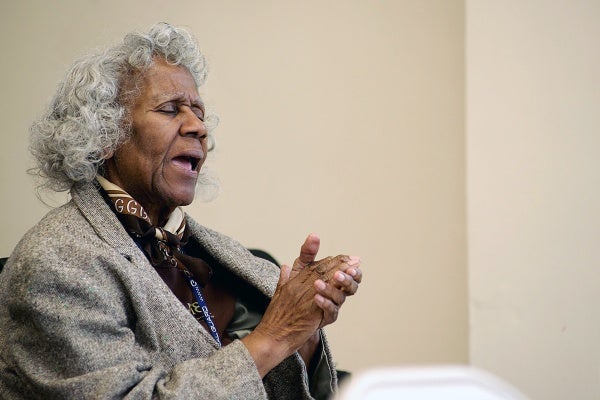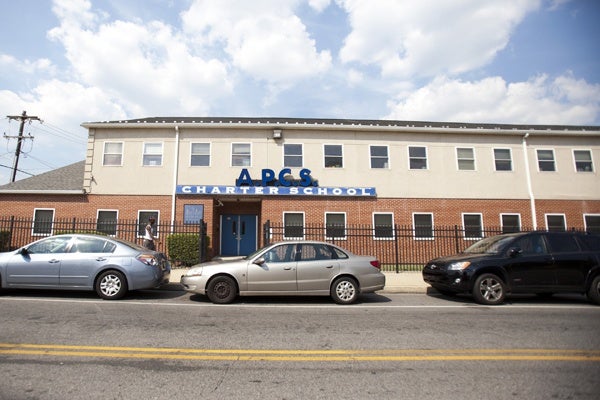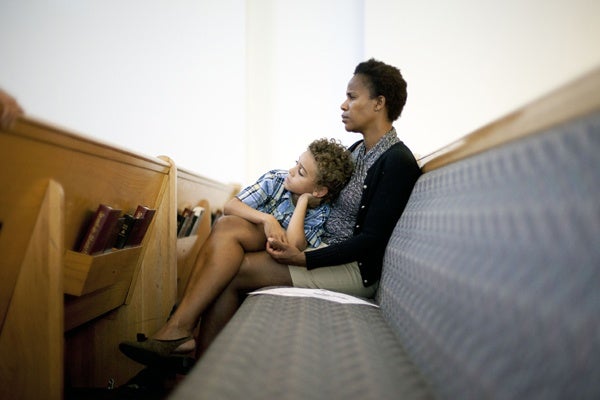For one mother, Philadelphia’s portfolio of school options brings opportunity and stress
As usual, Karen Lewis is trying to manage a dozen things at once. And as usual, Lewis’ son, 8-year-old Cooper Harbol, is the focus of her efforts. While Lewis cleans the kitchen and scrambles to find her shoes, Cooper gets lost in the elaborate toy world he has constructed on the coffee table. He’s oblivious to his mother’s pleas to brush his teeth.
“Cooper, put down the Lego, please,” says Lewis. “Today’s the first day of school. At least we can show up at a reasonable time.”
Third grade was supposed to be a fresh start for Cooper. But Lewis is exhausted before the year has even begun.
For the past six months, Lewis, 45 and divorced, has been navigating Philadelphia’s changing school-choice landscape. Dissatisfied with the neighborhood public school Cooper had attended since kindergarten, Lewis set out to find something better.
Her search has been fueled by anger and guilt.
“I had put my kid in a situation where he absolutely hated going to school,” she says. “I thought I had taken away his opportunity to be successful.”
In Pennsylvania and across the nation, reformers and politicians have been responding to parents such as Lewis by expanding charter schools and pushing for publicly funded vouchers. Empower parents by giving them more school options, they argue, and fewer children will be trapped in failing schools.
But for the time being, at least, the practical realities of school choice in Philadelphia are far messier than that.
In Lewis’ case, the district-run school she has grown to hate, John Moffet Elementary in Kensington, isn’t failing. Test scores indicate it’s one of the top elementary schools in the city. And Lewis’ search for a new school has left her feeling bitter, not empowered.
The vision of a coordinated “portfolio” of accessible, high-quality schools in every Philadelphia neighborhood remains far off. Despite Lewis’ master’s degree and professional background, she has struggled to negotiate the city’s confusing patchwork of roughly 500 district, charter, and private schools.
While driving Cooper to his new school, her frustrations pour out.
“I’m so angry, and so annoyed, it’s not funny.”
‘100 percent wrong’
Karen Lewis says she’s a big believer in public education.
But it’s a terrible feeling, she says, to also believe you are putting your child in harm’s way every morning.During Cooper’s second week of kindergarten at Moffet, says Lewis, staff at an afterschool program briefly couldn’t locate her son, then blamed her for the mix-up.
Things went downhill from there.
“It felt crazy,” she says.
“My expectation was that kids were going to be treated with respect, that they would be engaged in learning and having fun, that it would be an experience like I had in the suburbs.
“I was 100 percent wrong.”
Raised in Chester County, Lewis grew up comfortably middle class.
By her late 20s, she had a master’s degree in business administration from Kutztown University. Ten years later, she was married, working as a business consultant and living well in Las Vegas.
In 2008, says Lewis, she earned $130,000. Last year, she says, she made $24,000. The financial downturn was gradual. She stopped consulting to be around more for Cooper, then lost her accounting job.
By that point, Lewis and her son had moved back to Philadelphia, into a small row home in a gentrifying part of the city’s Kensington neighborhood.
Lewis had picked the house in part because it was close to a school with a good reputation.
She loved that Moffet was just three blocks away. She was pleased with its high test scores and racial diversity, as well as the positive reviews on parenting blogs.
“They talked about it as a neighborhood secret,” says Lewis.
It’s true: Other parents tend to love Moffet.
Every school has its challenges, says Laura Aboud, the mother of two Moffet students. But Moffet’s tend to be minor.
“You may not be able to get exactly what you want for your child in every instance,” says Aboud. “But I wouldn’t have [my children] anywhere else.”
By the time Cooper was in first grade, though, Lewis couldn’t tolerate things other parents shrugged off.She still couldn’t believe that as a kindergartner, Cooper got detention for being late.
She was outraged after witnessing school staff smoking in the school’s front entrance as children filed in.At one point, she says, she was barred from volunteering.
“I’m the type that asks questions when things don’t make sense, and they didn’t really want that,” says Lewis.
The final straw, says Lewis, was when children were denied lunch and bathroom trips as a form of discipline.By that point, it was a fight to get Cooper out the door every morning. He said he wanted to drop out of elementary school.
Lewis worried that her son was internalizing the worst possible message: that he didn’t matter.
“This is Cooper’s life,” she says. “I have to trust my instincts.”
A ‘portfolio’ of choices
Michelle Rhee has met hundreds of parents like Karen Lewis.
The former chancellor of the Washington, D.C., school system says it was those encounters that led her to fully embrace school choice.
“When faced with real-life kids and real-life situations, I couldn’t find it in myself to say, ‘I’m going to deny you [an] opportunity simply because I think you should stay in the traditional public school system,'” she explains.
Rhee is now the CEO of StudentsFirst, a California-based nonprofit pushing for more publicly funded school options.
“We think an ideal system has a vibrant and high-performing traditional public school system, a strong charter school system, [and] some kids who might be attending private school through a voucher program,” says Rhee.
In recent months, a similar vision has taken root in Philadelphia.
City education leaders are attempting to break down barriers among the district, the city’s 80-plus charter schools, and the Archdiocese of Philadelphia. The Pennsylvania legislature recently passed a new “opportunity scholarship” program. And philanthropists have poured more than $50 million into the Philadelphia School Partnership, a 2-year-old nonprofit that wants to expand successful schools, regardless of management model.
“We’re trying to think of it as one city, one large student population, many diverse providers,” says Mark Gleason, PSP executive director.
A 2010 study by the Pew Charitable Trusts’ Philadelphia Research Initiative lends credence to that cross-sector “portfolio” approach. Of the Philadelphia parents surveyed, 72 percent said they wanted more good school options. Many said they care less about labels – public, private, charter – than about quality.
Philadelphia has had a diverse mix of schools for decades, says Lori Shorr, the city’s chief education officer. But a lack of coordination across sectors means that poor families have to make a herculean effort to access good options.
“If we have a well-managed portfolio, parents [will] have the opportunity to choose a school that fits the needs of their kid,” she says.
A difficult decision
But for Karen Lewis, that vision is not yet reality.
Despite months of searching, she found only two options she considered viable: Alliance for Progress, a charter school in North Philadelphia whose test scores paled in comparison to Moffet’s, and Greene Street Friends, a private Quaker school in Germantown that costs $13,000 a year.
On a hot Friday in late August, Lewis and Cooper arrived 10 minutes late to the North Philadelphia Seventh Day Adventist Church for Alliance’s new-family orientation.
As soon as they walked in, Cooper informed his mom that he left his Legos in the car.
He’s a slight boy with a copper complexion, unruly curls, and huge dark eyes. Like many 8-year-olds, he alternates between clingy and distant.
After retrieving his toys, Cooper knelt between two pews, lined up rows of small figures, and faced them off for battle.
His mother listened intently.
“Charter schools are here for parent involvement,” said Tina Lloyd, Alliance’s lower school principal. “You have a voice.”
About two dozen parents and grandparents – all African-American, and nearly all women – listened quietly to a litany of rules on everything from lateness to homework.
Not until Lloyd brought up Alliance’s uniform policy did anyone ask questions: What kind of shoes are OK? Can girls wear beads in their hair?
“We know kids have their individuality,” responded Lloyd. “We appreciate that, but not during school.”
Lewis felt lucky just to be in the room. She only found two charters with available third-grade seats. Cooper was 67th on the wait list at the first school. At Alliance, says Lewis, he started out 35th, then he moved to sixth.
She got the news he was admitted while shopping at Target. She gave a fist pump, then started crying, right in front of the Lego display.
But after Alliance’s presentation, Lewis was lukewarm.
She wasn’t sure about its rigid structure and lack of enrichment programs. She worried about the 20-minute drive.
A week later, Lewis and Cooper attended the orientation at Greene Street Friends. The meeting house was packed with a multicultural mix of men and women.
“As you know, the mission to provide a first-rate education for your children and to follow Quaker values is an expensive proposition,” Emily Harmar, the school’s director of annual giving, told the parents.
“We’re counting on you, and welcome to Greene Street.”
For Lewis, enrolling Cooper would mean depleting her savings, selling her stock, and asking her ex-husband to contribute half of the deposit.
“I can’t afford it,” she says flatly.
But as a parade of Greene Street staff spoke of small class sizes and hands-on learning activities, Lewis’ brow knotted in concentration.
Science teacher Josh Goodstein told the parents that his goals are twofold: to get children prepared for the city’s elite high schools, and to help them love learning.
“I’m sure [your children] love discovering things,” said Goodstein. “That’s really what science is about.”
Lewis was sold. If she could come up with the money.
The downside of choice
Lewis’s search was leaving her emotionally drained.
Choice proponents say that’s why more good options are so urgently needed.
Karran Harper Royal says it isn’t that simple.
For 20 years, Harper Royal has been a public school parent in New Orleans. She’s a founder of Parents Across America, a nonprofit network of progressive activists.
In the aftermath of Hurricane Katrina, New Orleans became the nation’s largest school-choice laboratory. Now, 75 percent of its schools are charters. There are no more default neighborhood schools – all parents must apply to the schools they’d like their children to attend, then hope they get in.
In New Orleans, says Harper Royal, there are a lot of parents who feel like Karen Lewis.
“They, like me, had high hopes for [choice] transforming our system and getting us … high-quality schools in all of our neighborhoods,” she says.
“We have created some good schools. But we need to get busy creating a good school system.”
Many would disagree with her assessment. Between 2009 and 2011, the percentage of New Orleans parents satisfied with public school options in their city jumped from 31 to 66 percent, according to a survey conducted by Tulane University.
But Harper Royal argues that many New Orleans children travel great distances to and from school. Many parents feel that an emphasis on standardized tests has resulted in too many options that all feel the same. And some worry about the constant “churn” of schools being opened and closed.
“Some people see that as a positive thing,” says Harper Royal. “I see it as experimenting with children’s lives.”
New Orleans parents want choices, she says. But they also want strong neighborhood schools they can count on.”[Parents] don’t want to have to travel all over the city to find a school that works,” says Harper Royal.
“They want a school that is the heart of their community.”
Philadelphia education leaders are studying cities such as New Orleans, Denver and Boston to see what works in other choice-based portfolio systems – and what doesn’t.
“We’re at the beginning of this,” says the city’s Shorr.
“Philadelphia needs to figure out for Philadelphia what the best model is.”
‘Not a successful day’
Karen Lewis ultimately decided to bite the bullet and send Cooper to Greene Street. She says it’s the closest thing to a “normal” educational environment she could find.
“School will become fun for my son,” says Lewis.
But she’s still not sure how she’s going to come up with the second tuition payment.
During the 20-minute drive up Germantown Avenue on the first day of school, Cooper worries about lunch and making friends.
Lewis turns reflective.
“This is not a successful day for me,” she concludes. “It’s actually sad that I would have to do this.”
Outside the school, Lewis parks her car, then turns to her son.
“I’m going to walk in with you, OK? Mom has got your back.”
As Cooper takes his new seat, Lewis lingers in the classroom doorway, watching, wondering if she made the right choice.
This story was reported as part of NewsWorks’ partnership in education coverage with the Public School Notebook.
WHYY is your source for fact-based, in-depth journalism and information. As a nonprofit organization, we rely on financial support from readers like you. Please give today.




























































